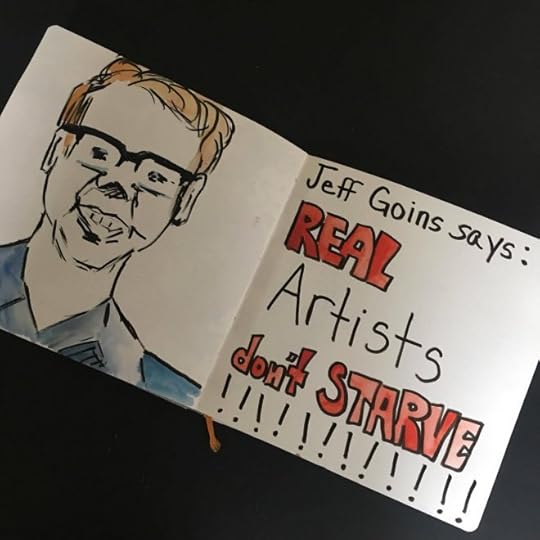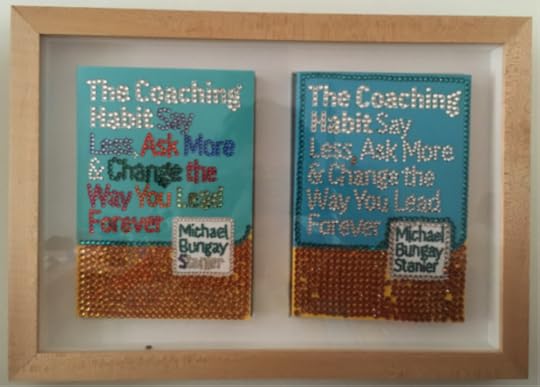Jeff Goins's Blog, page 27
April 20, 2017
The Writer’s Roadmap: 12 Steps to Make a Living Writing
It never fails. Every week, I overhear a conversation at a coffee shop or get an email that essentially says the same thing:
“Writers don’t make any money.”
I’ve heard teachers and relatives and even authors themselves say this. But is it true? It doesn’t have to be.
Yes, we have all heard the tales of starving artists. But here’s the other side of that story:
You don’t have to starve.
Not today. Not with the countless opportunities that exist to share your message with the world.
“MYTH: Writers don’t make any money.Tweet thisTweet
You can make a living writing
Every year, I see writers do this. I see them bridge the gap between barely surviving and making a great living. I’ve personally taught hundreds of them each year in my Tribe Writers course and applauded as they’ve seen their dreams come true.
Here’s the deal. I’m tired of this whole “starving writer” thing. It needs to go away. So, recently I documented the process that all professional writers follow to turn pro.
And today, I want to share it with you.
If you haven’t gotten a chance to download my new free guide yet, get it right here: 12 Steps to Make a Living Writing.
Click here to watch a tutorial as I walk you through the writer’s roadmap and explain the 12 steps in detail.
The myth of the starving artist has dominated our culture for long enough. It’s time to equip writers and creatives with the tools to make a living from their craft.
Are you feeling stuck? These resources will help you. Get started by downloading the guide and watching the free video.
Where do you feel stuck in your writing? What do you hope to accomplish with your writing? Share in the comments.

April 17, 2017
Writers: You Don’t Have to Starve (If You Do This)
A friend of mine recently did a survey of a few thousand writers, asking them how much money they make off their writing per month. Do you know what they said? Can you guess? A few thousand bucks a month? A few hundred? Not even close.
According to this study, the average writer makes less than a dollar a month off their writing. A dollar. A DOLLAR?!! That’s insane, and in my opinion, unacceptable. Sadly, though, it’s true.
Based on my conversations with the hundreds of thousands of writers who read my blog every month, most of them aren’t making money off their writing. Like, none.
Another study I found was done by Writers Digest, and the findings weren’t much better. Out of the 7000 working writers surveyed, over 77% didn’t make more than $1000 a year off their writing.
Look. I know it’s no surprise that writers don’t make a fortune off their work, but a dollar a month? A thousand dollars a year? We can do better.
And yet, for every group of Starving Artists out there, we occasionally stumble across an individual who defies the odds and breaks through the glass ceiling of what’s possible. These are those elite few we tend to call “lucky” and “privileged.”
But are they really?
The truth is some writers make very little money and some make a lot of money. In fact, writing may be one of the few jobs where the minimum and maximum earning potential are practically limitless.
With other jobs, like law or medicine or even food service, there is some minimum salary to which you are entitled. Not so with writing. That makes this a little risky. But you knew that already. 
April 14, 2017
How to Start a Blog Even if You Aren’t an Expert
Were you ever on the cusp of hitting publish on a blog post, hand hovering over the mousepad, and suddenly this thought floods your brain:
“What do you have to offer? You aren’t an expert.”

You hesitate. You pull back. You click ‘Delete’ instead.
Has this ever happened to you?
If so, you’ve encountered imposter syndrome, a notorious killer of goals and dreams. Imposter syndrome is the feeling of inadequacy, like you’re not good enough or don’t deserve your situation.
As bloggers, we even let it get the best of us. Sometimes it holds us back from exploring new topics or new styles. Other times it prevents us from simply starting a blog.
For years I let imposter syndrome dictate my blogging journey, until I discovered a method to circumvent it. It’s a method that allows you to create an endless cache of ideas for you and your readers. It opens up for you opportunities typically reserved for ‘experts.’ It even gives you the leeway to enjoy failing.
This process is commonly known as: Learning out loud.
Learning out loud is the method of documenting your journey as you learn something new. Whether it’s learning how to build a side-hustle, or learning how to cook, or learning how to start an urban farm, learning out loud treats your life as an experiment where you get to ask the questions, and seek the answers.
What would happen if I tried to lose weight?
What would happen if I left my full-time job for my passion?
What would happen if I learned how to play the piano?
What would happen if I…?
When you start asking questions, and start searching for answers, there’s absolutely no reason to succumb to the power of imposter syndrome, because you aren’t claiming to be the perfect expert. You’re just inviting people along for the journey.
How I learned my way out of a job
Palms sweaty. Mouth dry. I clicked the dialer on Skype.
…Ringing… …Connecting…
“Hey Declan!” Jeff said on the other end.
“Show time,” I thought.
Two years ago I signed up to interview Jeff Goins about his new book, The Art of Work. I took a half day at work so I could be home for the interview. I had thirty minutes, and I wasn’t about to waste this opportunity.
I knew Jeff had successfully built up his passion to the point where he could leave his full-time job. I wanted to discover his secret.
At the time I was 5 months into my new job at a new company. I left my post-college employer for greener pastures only to find the new pasture was just the same. As a young, ambitious, and creative individual, I felt trapped in corporate America. I wanted out, but I had no idea what to do.
Jeff and I talked for a few minutes, I asked him some standard questions about his book (Why did he write it? What inspired him? etc.). However, after twenty minutes, I couldn’t hold it in. I straight up asked him, “At what point should someone take the leap and go full-time with their passion?”
Jeff paused. Hoping for a specific dollar amount or a clear-cut timeline to help me out, I eagerly waited his response.
“It’s not about taking a leap, it’s about building a bridge. I think what that practically means for you, Declan, is looking for those opportunities to take the next step to get you to where you want to go. Use your current context to practice and prepare for what is to come and actually start building the thing on the side. So when those opportunities come, you’re ready for them.”
“It’s not about taking a leap, it’s about building a bridge.Tweet thisTweet
Until that moment, my blog was a mishmash of topics with no sense of direction. Use your current context to practice and prepare. What did I want to practice and prepare for? Self-employment. From that moment on, I documented my journey in blog posts, Facebook Lives, a book, podcasts, Instagram, word of mouth and more.
I broadcasted my journey from a full-time job to self-employment because it was the only way I would learn. It was also a way to inspire other young people to go after the life they wanted.
And in June of this year, I’m finally leaving my full-time job, all thanks to learning out loud.
Why learning out loud works
1. Learning out loud supplies you with endless topics to explore
In college my wife (then girlfriend) and I started a cooking blog to help us learn how to cook. We’d find a new recipe, prepare it, take pictures and share the results on our blog. When we first toyed with the idea of starting a cooking blog, my wife questioned whether we would eventually run out of things to write about.
Even though the focus of our blog was simple: two college students exploring the world of the kitchen, we never ran out of ideas because there was always something new to learn. Once you venture down the rabbit hole of learning out loud, you’ll find more and more to write about without steering away from your niche.
2. Learning out loud affords you the luxury to share your failures
The surefire way to build trust and transparency with your readers and give them value is to share your failures. Not in a woe-is-me rant, but in a way that demonstrates your relatability to your readers’ struggles.
For example, if you write a post, 10 Reasons Why I Suck at Cooking Eggs Benedict, your readers will then have 10 reasons how to not suck at cooking Eggs Benedict and avoid the mistakes you made. (True story, my wife and I tried cooking Eggs Benedict and really screwed up. We never published the recipe because we were too embarrassed, lesson learned.)
When you learn out loud, every experience is another data point to share. Some experiences may be embarrassing to share, but remember, if there is a lesson to be learned then it’s worth sharing!
3. Learning out loud is an excuse to push yourself outside of your comfort zone
Did you ever stand at the edge of a pool with a couple friends? Each of you speculating the water’s temperature. One friend dips her toe in the water to test it, but her reading is inconclusive. Instead, you muster up some courage and take the plunge! That’s what learning out loud does for you. It forces you to ‘take the plunge’ so to speak and gauge the water’s temperature yourself.
At the present moment, it would take a lot for me to walk into a ballet class and dance for the first time. It would, however, feel slightly less uncomfortable if I did it to document my journey for a fitness blog focused on overcoming male stereotypes. In other words, when you learn out loud, you have a greater purpose that helps to push you outside of your comfort zone.
5 platforms for a blogger to learn out loud
Building your tribe on another person’s land is not the best strategy. Owning a blog to use as a ‘hub’ to build your tribe is essential for anyone who wants to take learning out loud seriously.
However, people’s attention is shifting, and we have to adapt to meet them where they are today. Without the help of SEO, a new blogger can struggle with finding their tribe. That is unless, they are willing to venture out onto different platforms to document their journey.
Diversifying your digital footprint will attract people back to your blog where you can begin building your tribe.
Here are the 5 platforms you need to try while learning out loud:
Snapchat
Quora
Medium
Snapchat
With face filters, geo filters, stickers, doodles and more, Snapchat allows you to easily capture to small moments throughout the day. You can share your whimsical and silly side, family life, or behind the scenes of you learning out loud.
People who follow me across multiple platforms know how hard I work on my business and projects. However, I use Snapchat to share the fun moments in my day. I even had someone message me saying they enjoy my “Learning-how-to-Dad” series on Snapchat. Which is funny because I never created a formal series, that’s just my real life they are seeing!
To really make an impact on Snapchat you need to be proficient at three things:
Tell entertaining and engaging stories in short 10 second bursts
Not take yourself seriously
Convey a consistent message
Instagram Stories
I want to specifically call out Instagram Stories, which is a newer feature to Instagram. Stories is similar to Snapchat in that the content disappears after 24 hours. However, there are a few added perks:
15-second clips instead of 10 seconds
The ability to ‘tag’ other accounts in the story
The ‘Swipe Up’ feature to link to hyperlinks (currently for verified accounts but supposedly will roll out to the general public soon)
Uploaded photos look native (unlike Snapchat where it’s obviously an uploaded photo)
Easier discoverability
Bigger potential for reach
Access to a profile page of permanent content
The ability to broadcast Live
Whereas, Snapchat is more fun and whimsical, Instagram Stories is more ‘on-brand’ and true to your niche.
Quora
I’m going to be honest, Quora is a platform I’ve recently started to explore after my friend Todd Brison shared how it’s a trove of endless ideas. If you want to learn out loud, Quora is exactly what you need. As a blogger, you can use Quora to test ideas by responding to questions and seeing which ones stick. It’s also a great place to generate ideas for blog posts.
For example, I recently wrote a blog post about lack of motivation. I found this question on Quora and read the top 5 answers. I used those answers to structure my thesis of my post. My assumption being, if these are the top responses, these must be what people want to read. The post has since become my third all time viewed post on Medium.
You can also use Quora to build out your digital footprint. Let’s say for example your goal is to write a book. Hop on Quora, search ‘How to write a book?’ and start answering questions. Use your learning out loud ‘experiment’ to share what’s worked and what hasn’t worked. The more you answer questions in your niche, the more your audience will find you because they are searching for answers too!
Medium
In late 2016 I closed up shop on my second blog to focus entirely on my business and building my following on Medium. This was even before they came out with some new features (more on that in a bit). Medium is the place where ‘bloggers’ become ‘writers.’ It’s the place where great content is discovered and receives the attention it deserves.
I could write an entire series on how to use Medium, but if you are starting out it’s simple: write great content and interact with other writers. That’s your recipe for success.
Medium is ripe for sharing stories of learning from failure. It’s also a great place for learning out loud. Personal development, entrepreneurship, life lessons, and writing dominate the most popular subjects.
For example, I struggled for four months to land my first client for my business. It then took me less than two hours to land my second. Excited to share my ‘success,’ I wrote a quick post about my struggles and encouraged other entrepreneurs to keep pushing forward to land their first client/customer. The post became my most popular post to date and even lead to more clients.
Facebook (with an emphasis on Live)
It may sound ‘old-school’ but Facebook is still the world’s largest platform. However, the ability to ‘Go Live’ on Facebook is still relatively new and is due in part from the greater consumption of video online.
With Facebook Live you can share the raw, organic moments of your day. After I launched my book last year, I did a weekly book study on Facebook Live. It wasn’t scripted, it was me and my readers interacting in real time.
Unlike Snapchat and Instagram Stories, Facebook Live pushes you to entertain and educate your audience for longer periods of time. If your goal is to turn your blog into speaking engagements, Facebook Live is an excellent training ground.
Conclusion
Creating content is hard. Documenting your journey is easy. Don’t waste away those precious experiences because you think they aren’t important. There’s somebody out there waiting to learn from your journey. Teach them.
What are you trying to learn about right now? How can you document your journey and practice in public to reach your audience? Share in the comments.

April 12, 2017
150: Why a Book Deal is Only the Beginning of Your Writing Career: Interview with Annie Downs
The day you get your first book deal feels much the same as getting accepted to a prestigious university, or landing a coveted internship after graduation. However, much like college and your first “real” job, you soon discover the hard work has only just begun.
Precious few authors are fortunate enough to quit their day jobs after landing their first book deal. Most are unable to avoid the need for side income to supplement writing revenue even after publishing multiple books.
If you’re lucky enough to get a book advance, this week’s guest on The Portfolio Life recommends treating it like an investment rather than income.
Listen in as author and speaker, Annie Downs, and I talk about why traditional vs non-traditional publishing is not a clear cut decision, and confront the stereotypical mindset of publishing a bound book versus exploring different mediums.
Listen to the podcast
To listen to the show, click the player below (If you’re reading this via email, please click here).
Show highlights
In this episode, Annie and I discuss:
The hyperbole of reactions when people find out you’re a full-time writer
Growing up with a love of books
Who does hitting the New York Times bestsellers list really matter to
Bridging the gap between getting started with nothing and touring as a speaker
Honoring commitments and being faithful in small things and meet deadlines
Why being scrappy is a competitive advantage
The creative process as a partnership
Why first drafts are awesome
Applying for day jobs to make ends meet the week a book came out
Modeling her company after Lady Antebellum
Establishing a personal board of directors
Thinking of your writing career as a business
Feeling like quitting anytime something felt hard.
Quotes and takeaways
“No is not about you, it’s about clearing out the space for the right thing.” –Annie Downs
We see rejection and failure as an obstacle and it can also be an opportunity.
Take yourself out of the center of the story to understand the greater arc of what’s being told.
“It is not wise to treat a book deal or an advance like income. Treat it like an investment in your company.” –Annie Downs
“The bigger your advance, the longer it takes to ever see money again.” –Annie Downs
You may turn in the first draft, but it takes a lot of people to create the final version of the book.
“If you’re talking to the people in your tribe, other people are going to listen.Annie DownsTweet thisTweet
“Hustle is seasonal.Annie DownsTweet thisTweet
Resources
Melanie Shankle’s Big Mama blog
Sophie Hudson’s Boo Mama blog
Learning to Savor: Interview with Shauna Niequest
The Best-selling Author with a Day Job: John Green
Annie Downs on Twitter and her blog
Podcast sponsor: Product Creation Masterclass by ConvertKit
What are you doing differently to try and get a book deal? How are you treating your writing like a business? Share in the comments
Click here to download a free PDF of the complete interview transcript.

April 10, 2017
“Real Artists Don’t Starve” is Coming Out (And I Need Your Help)
Waiting for your book to come out is a lot like waiting at the hospital for your child to be born. I have two kids and four books, so I feel semi-qualified to use the analogy. That said, I still can’t believe my fifth book is almost here.

My newest book, Real Artists Don’t Starve, is coming out June 6th. But that’s not why I’m writing today…
Official book announcements call for a lot of pomp and circumstance and that is not what this post is about. Now, there will be a formal announcement soon enough with exclusive bonuses for those of you kind enough to preorder the book.
I’m writing to you today because I need your help.
For too long, the myth of the starving artist has dominated our culture, seeping into the mind of creative people and stifling their pursuits. The truth is that the world’s most successful artists did not starve. And you don’t have to, either.
Rather than starve, these fixtures of art history textbooks and legends of literary anthologies capitalized on their creative strength. And so can you.
In Real Artists Don’t Starve, I debunk the myth of the starving artists by unveiling the ideas that created it and replace them with timeless strategies for thriving.
Becoming an artist in any craft takes time, effort, and a community to challenge and support you. That’s where you come in.
This book (or any book) can’t sell itself, I need your help getting the word out.
Do any of your friends have an influential social media following?
Are some of your buddies hosts of a podcast?
Do you work at a media outlet?
Are you connected with a community of makers, creatives, or artists?
Any suggestions, introductions, or help you can offer is greatly appreciated. If you’ve enjoyed this blog, The Portfolio Life podcast, or any of my books thus far, this is your chance to get involved.
Just click here or fill out the form below to send me any ideas or recommendations. I’ll take the best ideas and try them out. And for those of you with some big ideas about how you can help with this book launch, I’ll invite to a private launch team.
I’m really excited for this book to be released this summer and to start changing the lives of creatives everywhere.
Gratefully yours,
Jeff
P.S. The “official” announcement will be coming quicker than you think. But, if you pre-order now, you will get exclusive bonus materials in the coming weeks. Click here to reserve your copy.
Loading…

April 5, 2017
149: How to Sell 1000 Copies of Your Self-Published Book on Day One: Interview with Paul Sohn
The average self-published book sells 250 copies in its first year and maybe 1,000 copies in its lifetime. Most authors are ecstatic if they hit 1,000 copies in the first three months. But what if you sold 1,000 copies of your book on the first day it released?
Now, there is no such thing as an overnight success. Work that lasts and resonates with your audience requires consistent effort over an extended period of time.
Without a platform, without an email list, and without a community, you could not self-publish a book tomorrow and reasonably expect anything but dead air in response.
However, if you put in the effort, do your research, and engage with influencers and your target audience to build a loyal tribe, the sky really is the limit.
This week’s guest on The Portfolio Life, successfully self-published a book and sold over 1,000 copies on the first day it released. Within a week he was connected with seven traditional publishers, landed a book contract soon thereafter, and has just launched Quarter-Life Calling.
Listen in as Paul Sohn and I talk about how to decide whether to self-publish or pursue a book contract with a traditional publisher, realizing the emptiness of a “dream job” at a young age, and redefining what it means to achieve success.
Listen to the podcast
To listen to the show, click the player below (If you’re reading this via email, please click here).
Show highlights
In this episode, Paul and I discuss:
Redefining what it means to achieve success
Writing a book for yourself
Unpacking the decision to self-publish
Living out the principles of your book before publishing it
Building an influential network on Twitter and Facebook
Developing a book launch team
Hacks and tricks to boost Amazon rankings
Connecting with 7 different traditional publishers one week after self-publishing
The supplemental benefits of creating a platform that goes beyond the book
Establishing a personal board of directors
Picking whichever publishing method aligns best with your goals
Quotes and takeaways
The essence of life is discovering your calling. Which will help you to live more purposefully.
“It’s one thing to write a book. It’s another thing to live a book.” –Paul Sohn
Discovering your calling and aligning your life around it will require uncomfortable shifts.
Follow the advice of experts without arguing to get the results you want.
“Your quarter-life could be the best time to discover your calling in life.” –Paul Sohn
Just because you write about something, doesn’t mean you are an expert.
Any measure of fame or notoriety can be accompanied by loneliness.
Simply writing a book doesn’t entitle you to anyone’s attention.
“You can’t 100% predict the outcome of your launch.Paul SohnTweet thisTweet
Resources
Quarter-Life Calling by Paul Sohn
The Call by Os Guinness
Your First 1000 Copies by Tim Grahl
Behind the Man Behind the Muppets
Millionaire Messenger by Brendon Burchard
Pre-order Real Artists Don’t Starve
Podcast sponsor: ConvertKit’s new Masterclass
Are you planning to self-publish or traditionally publish? Why? How are you living out what you write about? Share in the comments.

April 3, 2017
Most Book Trailers Are Awful (But Here’s How Yours Can Be Different)
Today, the trailer for my new book, Real Artists Don’t Starve, just came out. I’d love your thoughts on it. But before we do that, here’s a question we all should consider: Do book trailers even matter?
The short answer is no. Not really. No one ever bought a book because they saw a 60-second video on YouTube. I’m fairly confident in that. So does that mean you shouldn’t do a book trailer? Maybe, but only if you’re going to do one poorly. And poorly is the way nearly everyone does them.
My first book trailer was awful. The second one was great. The third was even better. And by the fourth, I feel like we’re finally figuring this thing out. So what made the difference? The way we approached the process.
For the first trailer (which was for my second book), I met with a video crew and stared awkwardly into a camera for five minutes, talking about myself. I didn’t have any experience as a speaker and didn’t understand what a good trailer was supposed to do. Not surprisingly, it flopped.
With the second one, we didn’t do any of that. My publisher provided a top-notch video editor, we wrote a script, and we kept it short. It went well, gaining over 20,000 views on YouTube in a few short months. The next time we did it, it went even better. And on and on it went.
Here’s what we learned:
We made it about the reader, not the author. In fact, I wasn’t even in it, which was good. Every person wants to believe they’re the hero of their own story, so we spoke to that desire.
We talked about the idea behind the book, not the book itself. Most people don’t want to buy books. They buy solutions to their problems, so we addressed a universal struggle.
We didn’t tell people to read the book, we invited them into a movement. Everyone wants to feel like they’re a part of something important, something bigger than themselves, so we piqued their interest with an invitation. If they buy into the movement, they’ll buy the book.
Most book trailers aren’t very good. Actually, that’s being generous. Most book trailers are lame. They’re boring and insulting to the reader. Just like a good book cover, a trailer should respect its audience. Why am I sharing this? Because I love books and hate seeing them represented so poorly.
Which is why I was excited to see the trailer for my latest book. I think it satisfies all three of the criteria above and is beautifully designed. But I’ll let you be the judge of that.
For those of you who are wondering, I think for a book trailer to work, you have to go above and beyond expectation. Here are three ways to do them right.
Strategy #1: Crowd-source the book trailer
Tim Ferriss did this for The 4-Hour Body, turning his trailer into a crowd-sourcing campaign, and it went really well, with thousands of people participating. The benefits of this are it’s fun and you get free promotion that doesn’t look like promotion (which is the best kind).
I actually did this for my first book. Though there was no official trailer, I asked my audience to shoot videos of themselves promoting my book and gave $100 gift card to the best one. This resulted in hundreds of videos being posted about my book, and some of them were really good. Here’s the winner of that contest (which was so much better than the video I did).
The benefits of this are it’s fun to do and you get a ton of free promotion that doesn’t look like promotion (which is the best kind). You also get a lot of great ideas that you can apply to your own trailer if you choose to make one.
Strategy #2: Sell the idea, not the product
Remember: people don’t watch book trailers. So make it something they might actually want to see — like a story in itself. That’s what I did with the trailer for The In-Between (my third book). It was more about selling the idea than it was about selling the book. When you get an idea to spread, as Seth Godin says, you win.
Here’s that video (which is still one of my favorite book trailers ever — and as you can see, it got a lot of views online):
You might even think of it as a mini-documentary, not a trailer. I like how Bryan Harris did this for his online course, publishing a series of mini-documentaries about people who built online businesses. Those videos received tens of thousands of views each and outperformed nearly any other video promotion he had ever done. In fact, I cried watching one of them — twice.
Here’s the trailer for that series:
Strategy #3: Pretend it’s for a movie, not a book
I’m really proud of the the past three trailers I’ve done for my books, especially the most recent one. But the first couple attempts weren’t great. That’s because I treated them like book commercials instead of movie trailers. But as I already mentioned, a good promotion is about selling the idea, not the product.
Most book trailers are terrible because they’re trying to promote something that’s hard to sell on video. Instead of doing that, why not make it interesting? Grab the audience’s attention and invite them into something bigger than themselves. Ryan Holiday did just that for The Obstacle Is The Way, which you can watch below. It’s not about the book. It’s about the idea.
But you don’t have to have a ton of money for this. You don’t even have to have a lot of fancy equipment. The trailer for The Art of Work was a simple, inexpensive piece of marketing material that did really well for the book. It doesn’t take a big budget, necessarily, but you do have to understand one thing: it’s about the idea. Here’s that trailer for your reference, by the way.
So that’s my two cents on book trailers. Whether you’ve produced a one or not, remember that successful marketing is about spreading a worthy idea in an interesting and surprising way that ultimately makes your audience the hero. And video is a powerful way to do that, so long as you do it right.
“Successful marketing is about spreading a worthy idea in an interesting and surprising way.Tweet thisTweet
So, if you’re up for it, I’d love your thoughts on trailers, including my most recent one. And if you like what you see, please share.
Resources
How to Create a Viral Book Trailer [Tim Ferriss]
Behind the Scenes: How to Make a Movie Trailer for Your Product [Tim Ferriss]
How to Make a Book Trailer [Joanna Penn]
Real Artists Don’t Starve Trailer
For more help with video trailers, check out the following:
What do you think makes for a good book or movie trailer? Share in the comments.

March 29, 2017
148: How to Become a Prolific Writer and Publish Over 200 Books: Interview with Jerry B. Jenkins
Writing your first book is like running a marathon. When it’s finally over, you’re equally excited and exhausted. You might even be a little sick (of your book). Now, imagine doing that almost 200 times.
With my fifth book getting ready to release this summer, I can barely fathom the level of discipline and creativity required to produce 20 books in a lifetime, let alone a couple hundred.
This week’s guest on The Portfolio Life, has sold over 70 million copies of his 189 books (and counting) and yet maintains a humble demeanor, works diligently at his craft, and encourages other writers on their journey.
Listen in as Jerry B. Jenkins and I talk about how he got started writing at a young age, the hyperbole of public perception of writers, and the advantage of experiencing success later in life.
Listen to the podcast
To listen to the show, click the player below (If you’re reading this via email, please click here).
Show highlights
In this episode, Jerry and I discuss:
How writing was his answer to a calling
Achieving the freedom to write leisurely because you love it
Rejecting the idea of retirement
Not measuring success by sales or accolades
How not to get on the bestseller lists
The relationship between passion and purpose
What is within your control as a writer
If it gets easier to write as you publish more
When to say “no” to a writing project
Why deadlines are a writer’s best friend
How writing a book is like giving birth
Treating fear as a healthy motivator
What role procrastination plays in getting writing done
The myth of writer’s block and the truth behind it
Why perfectionism is a mask for fear
Getting a phone call from Stephen King
Writing without guilt and still being present for his kids
Quotes and takeaways
Writing may be the vehicle through which you answer your calling.
“You don’t get on the bestseller lists by trying to get on the bestseller list.” –Jerry B. Jenkins
Writing books doesn’t get easier. It gets harder.
“Writers don’t write because they are writers, they write because they have something to say.” –Jerry B. Jenkins
Schedule your procrastination
“Procrastination may be a prerequisite to being a writer.” –Jerry B. Jenkins
Just write something. It doesn’t have to be pretty.
“Writers are the only profession in the world who allow themselves the conceit of writer’s block.” –Jerry B. Jenkins
“The only thing I can control, is how much of myself I give to the quality of the writing.Jerry B. JenkinsTweet thisTweet
Resources
Left Behind Series by Jerry B. Jenkins & Tim LaHaye
Riven by Jerry B. Jenkins
Podcast sponsor: Tribe Theme by Notable Themes
What is writing to you? How are you answering a calling as a writer? Share in the comments
Click here to download a free PDF of the full interview transcript.

March 27, 2017
The Most Important Marketing Decision You’ll Make as an Author
While working on my latest book, I hired media strategist Ryan Holiday to help me promote it. When I did that, he asked for something I didn’t expect. He asked to see my manuscript.
“Why?” I asked.
“Because,” he said, “once a book is finished, the marketing is done.”
“Once a book is finished the marketing is done.@RyanHolidayTweet thisTweet
Thus began a year-long journey of writing and rewriting my next book, which comes out later this year. It was a painful, grueling effort but one that resulted in something I’m proud of.
The place where we began working, though, was not where I expected.
After I finished a rough draft of the book, Ryan told me to not write another word until making a very important decision. In fact, this just might be the most important marketing decision you’ll make as an author. He told me I had to decide what the book was actually about. I had to give it a title.
In this post, I want to share with you the step-by-step process I followed to get a very rough idea out of my head and onto paper and how I refined it into a compelling argument and title. I want to share with you what I learned and why I will be using this process for every single book I write after this and why I will always begin with the title from here on out.
I recommend you apply as much of this as possible, gleaning what you can for your own journey. I hope it helps.
Choosing an argument
“It seems to me that this is two books,” Ryan told me. “One about creativity and the other about how to not be a starving artist. The first is a category that is already over-crowded, and the second sounds interesting. I think you have to pick one. It can’t be two books.”
Ryan was right. I was writing two books. Fascinated with the research behind creativity and why it had become a popular subject of study lately, I wanted to know how the brain worked and how that influenced our creative efforts. But that book had already been written — a few times.
This other idea, however, was something new. Maybe even something fresh. Something I could get excited about. So I chose to focus on the starving artist angle, and that decision made a world of difference. Now that I had an argument — you don’t have to starve to be an artist — it was now time to find a title.
Exercise: When choosing an argument, consider the question: “What is your book about?” Can you capture the argument in a single sentence? My friend Marion likes to say, “All great writing is about something, and that something is not me.” Your big idea needs to be something memorable and interesting — to the reader, not just to you. Don’t move forward with writing the book until you have a well-formulated argument that can be summarized in a single sentence. For more on this, check out this podcast episode.
Brainstorming book titles
The first title of my book was The Creative Advantage.
It was based on the idea that maybe what makes many creatives and artists starve is the same set of tools that can help them succeed. But when I shared that title with people, I heard more than a few times, “I feel like I’ve read that book already. Didn’t I already buy it?”
Seriously. I probably heard that a dozen times.
So it got scrapped.
While working with my agent Stephen Hanselman (who has worked with Tim Ferriss, Dallas Willard, Jack Canfield, and others), what really excited both of us was Michelangelo’s story of how he was secretly a millionaire.
I found that interesting and thought it said something about what’s possible with art and business. Maybe you can be both, and perhaps Michelangelo is the example to follow.
So, we started calling it The Michelangelo Factor. I liked that. It was catchy intriguing. But I also secretly worried about folks who weren’t artists or didn’t know much about Michelangelo. Would they be intrigued, too? Plus whenever I told people that title, they kept calling it something else, like The Michelangelo Effect. Which worried me.
Maybe it wasn’t that catchy, after all.
So I kept considering alternative titles but nothing seemed to stick. So I went back to writing. Maybe the title would emerge the more I wrote.
Exercise: Brainstorm at least 3-5 titles that best encapsulate the argument of your book. These need to be clear and compelling, something that would dare readers to pull the book off the shelf. Whatever you do, when considering a title for your book, don’t settle. Make sure that your argument is clear and everything in the book, including the cover and title, point back to that one central idea. For more on picking the perfect book title, read this and this.
When in doubt, be interesting
So I wrote the starving artist book instead. It was another draft of the book I’d been working on, but this time more focused (I typically write about five drafts of a book before doing any serious editing). When he read that version, Ryan said, “It’s sort of like what you’re saying is: ‘Real artists don’t starve.'”
As soon as he said it, I knew that was the book title: Real Artists Don’t Starve.
It both scared and excited me at the same time. What would people think? Would it push them away? Would it stir up controversy? Was it actually true? When I ran the idea by my friend Marion, she said, “You don’t have to be right. You just have to be interesting.”
That took a lot of pressure off, but I wanted to dig a little deeper. I needed to test this idea. So I ran a series of polls on both Twitter and PickFu and was startled by the results: when people liked the book title, they loved it, but when they didn’t like it, they hated it.
I thought that was interesting.
Then I started asking friends — but not just random people off the street. I polled bestselling authors and popular bloggers and book marketers. I asked my friend Joe, who is an author and popular blogger. “That’s the title,” he said one day as a group of us sat down to eat brunch at a restaurant in Portland. “It has to be. I’m telling you right now. That’s what the title is going to be. I just know it.”
I wasn’t so sure, though. Because everyone I talked to either loved the title or absolutely hated it. And that worried me. The publisher wasn’t sure, either. In fact, all my marketing-savvy friends loved it, but some did not. So, I waited and waited, worrying about the right thing to do.
Then I started asking potential readers, people I met at events and conferences. One was accomplished fine artist, Cassia Cogger, who when she heard the title said, “Well, yeah. I mean, it’s true. You can’t starve. You have to make a living if you want to create art.”
Then she went and created an amazing piece of sketch note artwork that said, “Jeff Goins says… Real artists don’t STARVE!!!”

Finally, I asked Joel Miller, who edited my previous book, and he said, “Nope. All those other titles are dumb and this one just works. That’s the title.” He didn’t couch it in any formalities or niceties. That’s what I love about Joel. And so, because he knew it, I knew it.
Which is how my book became: Real Artists Don’t Starve.
Exercise: Once you have at least 3-5 titles, start running some experiments. Ask friends, readers, strangers. Get feedback before you decide. You don’t have to go with the most popular option, necessarily, but you want to make as informed a decision as possible. In the end, you need to choose something that will connect with the core audience you intend to reach with the book. And when in doubt, be interesting. For more on creating interesting content, read this.
Lessons learned and how to title your book
How did I know this was the right title? Well, I didn’t. But I chose it, anyway, because I believed it encapsulated the argument I wanted to say and because I did the work to validate the idea. That doesn’t mean some people didn’t disagree with it, but ultimately it felt like the right choice.
Here’s why (and what you should be looking for when you title your own book):
Feedback. Whenever I talked to someone whom I thought was the ideal reader for the book (think artists, creatives, writers), they almost always loved it. Not only did they love it; it challenged them. They resonated with it. People who didn’t care for it were rarely the target audience, but they said they were considering how someone in their shoes might interpret it. Also, people I respected were more sure about the decision than I was.
Controversy. When people liked the book title, they loved it; and when they didn’t like it, they really didn’t like it. I figured anything that was getting that strong of a reaction was bound to generate some conversation. A risk, of course, but one worth taking.
Risk. Finally, I figured it was better to say something strong that some people might disagree with than it was to pick something safe and forgettable.
So, that’s how I came to title my latest book. Now, here’s what I learned…
4 rules for titling books
Choosing a title for your book is the most important marketing decision you will make. If you get it right, it makes everything easier. If you get it wrong, it makes everything harder.
A book title needs to dare readers to pick up the book. That’s its one and only job — to get someone who’s never heard of you to consider spending $25 on a book they’ve never heard of before. So, err on the side of saying something controversial or unbelievable. Think The 4-Hour Workweek . You want people seeing your title, saying, “Wow, there’s no way that’s true!”
Make your title one part intrigue, one part description. Don’t make people guess what your book is about. Tell them. Consider Think and Grow Rich or How to Win Friends and Influence People , two of the best-selling business books of all time. These titles tell you exactly what is in them. For fiction, you can get away with something a little more poetic, but you’re still balancing intrigue with description. For example, To Kill a Mockingbird is not actually about killing birds, but it is about killing something innocent.
Make a counterintuitive promise. Include something surprising in the title or subtitle. Austin Kleon’s Steal Like an Artist is an example of this, as is Ryan Holiday’s The Obstacle Is the Way . Again, the title is a dare to the reader to pick it up, so make them think. If you don’t do it in the title, do it in subtitle. Malcolm Gladwell’s books all have relatively short titles but longer subtitles that follow this rule of mixing intrigue with description.
One person I asked about the book title said, “Man, I would pick up that book just to prove you wrong. I mean, I’m thinking, ‘Who does he think he is!?'”
That’s the kind of reaction you want to a book title, not “I feel like I’ve read this already.” It needs to grab the reader, daring them to pick up the book. That’s the most important decision you can make as an author: picking the right book title. Do that and everything becomes easier.
So that’s the process that got me here, and I hope it helps you get to wherever you’re headed.
Resources
Here’s a list of the resources I mentioned above:
How to Come up with Your Big Book Idea [Zero to Book]
How to Title Your Book [Book In a Box]
How to Pick the Perfect Book Title [Tim Grahl]
Pickfu (polling tool to pick the right title)
How to Create Interesting Content [Buffer Blog]
The Right (and Wrong) Way to Market a Book [Ryan Holiday]
Real Artists Don’t Starve (my new book!)
What do you think? How does Real Artists Don’t Starve strike you? What are some of your favorite book titles? Share in the comments.

March 24, 2017
3 Proven Book Marketing Tactics that You Should Probably Avoid
You finally emerge from the dark jungle of self-doubt and the tangled undergrowth of self-loathing that is the typical interior landscape of writing your book (it’s not just me, surely?)
Congratulations! Your “pub date” is inked on to the calendar and it’s exciting to think of this artifact, crafted in the smithy of your soul, out in the world at last.
Until you realized what you’ve always known. Creating the book is easy compared to figuring out how to market and sell the thing.
The rule of thumb I’ve heard is that 93% of books sell less than 1,000 copies. As I first heard those numbers more than five years ago and before the advent of dead-easy self-publishing, they may be overly optimistic.
Now, there are plenty of guides to help you prepare for this second stage. Jeff Goins and Tim Grahl are a dynamic duo. Michael Hyatt. Ryan Holiday. These are all people with the scars of success and failure whose stories are worth listening to. I’ve had some success too. My most recent book, self-published, sold over 180,000 copies in its first year, and a previous book, published by a New York publisher, has sold about 90,000 copies.
But as you consider what to do, it’s useful to consider what you won’t do as well. As I planned the campaign to make The Coaching Habit successful, there were three well-known tactics that I took off the table.
Why? Because when I admitted the truth to myself, I could see that pursuing them was magical thinking, the fantasy that somehow my book would be recognized, plucked from obscurity, and elevated to best-seller status.
Crossing these off my list, help me roll up my sleeves and get down to the hard work of making the tactics I could control have as much impact as possible.
Here are those three tactics (plus one other that might make you smile), so you can weigh the pros and cons for yourself.
1. The bestseller-list hack
Who doesn’t want “New York Times bestseller” splashed across their book’s cover? I certainly do. (So did Jeff.) But it’s not easy to achieve. The rule of thumb, at least for adult nonfiction books like mine, is that you need to sell 10,000 copies a week for two weeks, but — and here’s the twist — you also need to sell them through the right channels.
No one is entirely sure what those channels are (it’s not ebooks; it is certain mysterious bookstores). So while most of us like to think of the NYT bestseller list as a scientific calculation, it’s actually a bit of an art.
Now, this ranking on the NYT list is an almost impossible task if you’re not famous, or don’t have a big crowd at your back or a mega–TED Talk. But it is something you can buy if you know how. For a certain amount of money — it’s either high five figures or, more likely, low six — you can find a partner to facilitate copies of your books being sold through those NYT channels.
Is that ethical? It’s much debated among authors I know. There are some authors who are just making sure that real books that are really sold get counted towards the list, which seems OK. And then there are others who buy their own books and then get them counted, which doesn’t. (Here’s an in-depth article, if you’re curious.)
Anyway, I knew from the start this wasn’t something I wanted to pursue. For one reason, I’m keeping that $150,000 stacked in used twenty-dollar bills in my air-conditioning vents for something else. And, in all seriousness, I got clear that the goal was for this book to be considered a “coaching classic”, which meant I was playing a long game.
A week on a bestseller list wasn’t nearly as important as a commitment to keeping the book alive and important for at least five years. I bet that this long-term mindset (and willingness to invest over that time) was going to pay a better return.
Ironically and delightfully, I accidentally made it on to a list after all. The book spent one week on a Wall Street Journal list (#3 business ebook!) after we ran a BookBub campaign that managed to shift about 7,000 ebooks in a week.
2. The Burchard giveaway
Brendon Burchard is masterful at writing successful books. His books all end up on the NYT best-seller list, and he’s done a brilliant job at leveraging that fame for on-going success.
I’ve looked at what he does, and while I’m only guessing here, I think the essential parts of his book launch system are —
Building a huge and loyal list over multiple years.
Building long-term partnerships with others who’ve done the same (such as Jeff Walker). They cross-promote each other’s programs, and grow their lists (and sales) from these “Super Affiliates”.
Giving his book away for free + shipping and handling (about $7, so they’re sold at a loss, but not a huge loss) and adding the recipients to his mailing list.
Channelling these book sales through some sort of system, perhaps like the bestseller hack mentioned above, so the book hits the NYT list.
Having a wide range of programs to upsell to the people on his mailing list, so the book acts as a loss leader or at least a small signal of commitment and engagement. These programs also offer affiliate payments to his partners, so there’s the potential financial upside to promoting the original book.
It’s impressive. And even if I had wanted to, I couldn’t have pulled it off. I didn’t have the size of a list (ah, it’s always about the size), nor did I have a post-book upsell to offer to help my partners make some “real money.”
But even if this is beyond you, it’s worth seeing the genius in the system that Burchard’s built. Each book has credibility, and provides an easy and safe way onto his mailing list. He knows that the big win is not the book sale but having that person become a regular customer of his programs.
As you think about your book, it’s worth defining what role it plays in your business model. It’s almost guaranteed not to be a big “revenue source” on its own. So how does your book provide an introduction to the real way you make your money?
3. The Tim Ferriss blessing
In the good old days, you dreamed of being summoned by Oprah to come talk about your book. With the Oprah aura (or so the fantasy went), your book would surge to the top of every bestseller list.
For nonfiction books, Tim Ferriss is the new Oprah. Through his blog, his email list and his lengthy yet excellent podcast interviews, Tim has the eyes and ears of a huge fan base. One interview has helped a book hit #1 on the New York Times bestseller list. One tweet has helped a certain brand of sardines disappear from shelves. (It’s all laid out here.)
I haven’t used this strategy mostly because I haven’t found a way (yet) to get Tim’s attention. Only a personal introduction will do it with Tim, of course, and that still may not be enough: I’m sure the man is besieged with introductions from people he both knows and trusts.
I’ve not abandoned this one. But it’s a little like the Queen of the Andes plant, which only blossoms once in a hundred years. I’m keeping my eye on the opportunity. Who knows, something may happen and I may get a text from Tim saying “let’s talk.” But I’m assuming not, and I’m wasting no time hoping this will somehow happen.
4. The most expensive book in the world
So here’s the bonus, non-obvious idea. And you need to know, I really REALLY liked this idea. Inspired by British artist Damien Hirst and by the rap group Wu-Tang Clan, I thought I’d create the most expensive business book ever. A cover encrusted with diamonds à la For the Love of God. Pages handwritten on vellum by a calligraphy master. Presented in a box made of gold or perhaps of beautifully carved wood. Only one made, à la The Wu — Once upon a Time in Shaolin.
I wasn’t entirely sure how production would go. I think I’d have put it out as part of a Kickstarter campaign for a million dollars — or maybe two — and created only if someone actually bought it.
And think of the press!
My team put the kibosh on the idea. It was, they rightly pointed out, against our core values of Elegance and Tread Lightly. It was a vanity project. It was ridiculous. That said, Marlene, my awesome assistant, did make me a couple of bedazzled versions to help me feel better about it all.
But the lesson to take from this isn’t about being pro- or anti-bling. It’s about thinking about the marketing of the book right from the start. Rest assured, no-one and I mean NO-ONE cares about a press release saying your book has appeared on the planet. If you want press, you need to find a story. You need to rise about the noise and provide something that grabs their attention. Be funny. Be different. Be controversial.
“If you want press, you need to find a story.Michael Bungay StanierTweet thisTweet
Whatever your idea, you should probably expect it to fail. Almost nothing catches on. But occasionally it does. Scott Stratten is a guy to watch here. He’s launched a number of memes that have taken off, from this video to this story to the quoted-by-and-now-attributed-to-Brené Brown “Jackass Whisperer”.
How long is a piece of string?
There are an endless number of ways to market in your book. When you’re not sure, when you’re feeling vulnerable, when you’re feeling a little desperate, they can all sound good.
Strategy, in its essence, is taking a deep breath and saying Yes to a few things and in doing so, saying No to many things.
My wish for you: the courage to boldly pick a few marketing tactics and do them deeply, fully, madly. You of course will be taking your best guess at what works, and not all of it will. But don’t try and do everything. And start by crossing these tactics off your list.
What book are you working on? Which book marketing strategies interest you the most? Share in the comments













